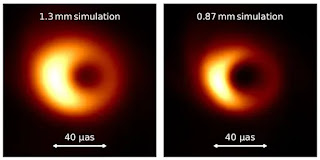Have you ever wondered what secrets lie hidden in the depths of black holes? What if we could peer even closer to these cosmic enigmas? The Event Horizon Telescope (EHT) Collaboration has just made a groundbreaking discovery that promises to revolutionize our understanding of black holes and galactic evolution. Join us as we explore this exciting new frontier in astrophysics and uncover what it means for our understanding of the universe.
What if we could see a black hole with unprecedented clarity? The Event Horizon Telescope (EHT) Collaboration has achieved just that, pushing the boundaries of astronomical observation to new heights. In this article, we'll delve into their latest breakthrough, which promises to unveil the mysteries of black holes like never before. By the end of this post, you'll understand how this advancement is set to transform our understanding of the cosmos and why it's such an exciting time for astrophysics.
EHT's Quantum Leap in Black Hole Imaging
The EHT Collaboration has recently made a quantum leap in black hole imaging. By observing light at a shorter wavelength of 0.87 mm, they've achieved the highest resolution ever obtained from Earth's surface[1]. This breakthrough allows us to peer closer to the event horizon of black holes, potentially revealing new details about these cosmic behemoths.
Computer simulation illustrating how a black hole looks like at different wavelengths. Figure credit: Christian M. Fromm, Julius-Maximilian University, Würzburg
Unveiling the Mysteries of Intermediate-Mass Black Holes
In a parallel development, astronomers have confirmed the existence of an intermediate-mass black hole in the Omega Centauri cluster. This discovery bridges the gap between stellar-mass and supermassive black holes, providing crucial insights into galactic evolution.
Implications for Our Understanding of the Universe
These advancements have far-reaching implications for our understanding of the universe:
- Sharper Black Hole Images: The EHT's new capability is expected to produce black hole images that are 50% more detailed than before.
- Galactic Evolution Insights: The discovery of intermediate-mass black holes helps us understand how galaxies and their central black holes grow over time.
- Testing Einstein's Theories: More detailed observations allow us to further test Einstein's theories of gravity in extreme conditions.
The Future of Black Hole Research
Looking ahead, we can expect even more exciting developments:
- Multi-Wavelength Observations: Future upgrades to the EHT will allow simultaneous observations at multiple wavelengths, providing a more comprehensive view of black holes.
- Black Hole Movies: With increased data collection capabilities, we might soon be able to create high-fidelity movies of the environment surrounding black holes.
- Discovering More Intermediate-Mass Black Holes: The confirmation of an intermediate-mass black hole in Omega Centauri opens the door to finding more such objects in other star clusters.
Conclusion
The recent breakthroughs by the Event Horizon Telescope Collaboration and the discovery of an intermediate-mass black hole mark a new era in our exploration of the cosmos. These advancements promise to unveil the secrets of black holes with unprecedented clarity, shedding light on the fundamental processes that shape our universe. As we continue to push the boundaries of astronomical observation, we can look forward to even more exciting discoveries that will reshape our understanding of the cosmos.
At FreeAstroScience, we're thrilled to bring you these cutting-edge developments in astrophysics. Stay tuned for more updates as we continue to explore the fascinating world of black holes and beyond!
Sources:
https://www.uclan.ac.uk/news/eht-higest-resolution
https://iopscience.iop.org/article/10.3847/1538-3881/ad5bdb
https://www.aip.de/en/news/black-hole-omega-centauri/
https://hubblesite.org/contents/news-releases/2024/news-2024-015.html
https://www.sciencedaily.com/releases/2024/08/240827105027.htm



Post a Comment